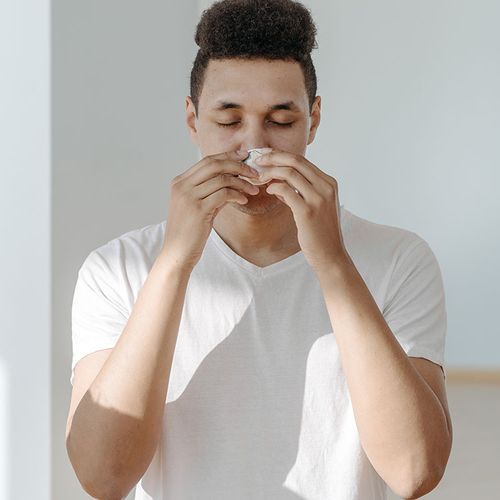Jeffrey May solves home air-quality and allergen problems for a living. He's also a lifelong allergy sufferer himself, as are his now-grown children. Here's what he uses to improve the air quality in his own home.
- High-quality vacuum. Most vacuums—even some expensive ones with high-efficiency particulate air (HEPA) filters—leak air while in use. Rather than collect dust and other allergens, these leaky vacuums actually churn up allergens and recirculate them throughout the home, reducing indoor air quality. Miele's HEPA Sealed System vacuums use high-quality filters and gaskets to dramatically reduce this problem.
Cost: $450 to $1,250, depending on the model. 800-843-7231, www.miele.com.
- Dust mite covers. Dust mites are microscopic organisms that thrive in warm, humid environments, such as bedding. A dust mite cover prevents mites from taking hold in your mattress-and kills dust mites that are already there by cutting off moisture. There are several varieties of covers on the market. The type I use-and the only type that works reliably-is a plastic mattress cover. My choice is Allergy Control Products' Economy Mattress Encasing.
Cost: $45.95 to $6995, depending on mattress size. A standard-size Economy pillow cover costs $995, 800-ALLERGY, www.allergycontrol.com.
If you don't like the feeling of sleeping on plastic, place a mattress pad over the dust mite cover. Wash and thoroughly dry this mattress pad every week or two to kill new dust mites. We also wash our blankets and quilts monthly and run them through the dryer on the regular setting every two weeks. Twenty minutes of drying should kill any dust mites living inside.
- Leather couches and chairs. Dust mites can infest fabric-covered couches and chairs, but they can't penetrate leather. All the chairs and couches in our home that we use regularly are leather. In less frequently used rooms, we have futon-style fabric couches, but we have encased the mattress portion of the futons in plastic dust mite covers, with the fabric futon covers over the plastic covers.
We also change our clothes immediately upon returning from places where we might have been exposed to pet dander, pollen or other allergens so that we don't contaminate our couches, chairs or beds.
- Hot-water radiators rather than a forced-air duct system. When you have a forced-air ventilation system, there's no way to know what's inside your ducts. Mold could be growing and spreading throughout the home whenever the system is used. Even professional duct cleaning is no guarantee that all allergens will be removed.
The only air-quality challenge presented by hot-water heat is dust building up on and behind radiators and/or baseboard units. We use a vacuum attachment called a flat crevice tool to remove dust from tight spots, such as behind radiators and refrigerators, Mid America Vacuum's 36-inch Exten-Vac Crevice Tool fits most vacuums.
Cost: $17.49, plus shipping, 800-649-7996, www.vacuumstore.com.
If you live in a home with a duct system, have the ducts cleaned at least once every five years. (Make sure the person you hire to do this cleans your coil and blower as well as the ducts. In the summer, we use portable air conditioners, which we clean with a solution of one-third bleach and two-thirds water yearly. We also replace the filters every year. Use high-quality airconditioner and furnace filters with a Minimum Efficiency Reporting Value (MERV) no lower than eight. If you have serious allergy issues, use filters rated at least 11.
- Hardwood floors. Carpets collect dust and other allergens, and not even the best vacuum can remove them all. For people like me who suffer from severe allergies, switching from carpets to wood or tile floors can be like flipping a switch from chronic bad health to good. That's particularly true in the winter, when we spend more time inside with the windows closed.
We do have a few small rugs in our home. They are synthetic, not wool or cotton, and I subjected each of them to a sniff test at the store before I brought them into my home. I put my face close to the carpet and inhaled deeply. If I didn't experience any allergic reaction, I purchased the rug.
- Dehumidifier in the basement. The relative humidity in our basement was above 50%, creating the risk of mold and mildew growth. I measured the humidity with a humidity meter. Extech (781-890-7440, www.extech.com) makes good ones, ranging from 530 to $200. Don't buy a cheap one-it won't be reliable. I then purchased a Therma-Stor Santa Fe dehumidifier, and we keep it set to lower our basement's relative humidity level below 50%. Therma-Stor makes the most powerful and reliable dehumidifiers on the residential market.
Cost: $975 to $1,375, depending on the model. 800-533-7533, www.thermastor.com.
I attached the dehumidifier to a condensate pump, a device available in hardware and homegoods stores for around $50. The condensate pump automatically transfers water collected by my dehumidifier to a sink in the basement.
- Face mask when I travel. I carry a face mask with me so that when I start to feel allergy symptoms, I can put it on. I use an N95 mask made by 3M, available in hardware stores,
Cost: About $20 for a box of 20.
Don't Count on Vitamin B-12 To Relieve Allergies
One recent clinical trial did show some improvement in allergy symptoms—after participants got 2,500 times the recommended daily allowance of three to four micrograms of B-12 for up to six weeks. But one trial is not conclusive-more research is necessary.
Good news: Even if vitamin B-12 does not help relieve allergies, it helps keep you healthy. But don't take huge doses of B-12 or any vitamin without consulting your doctor first.
